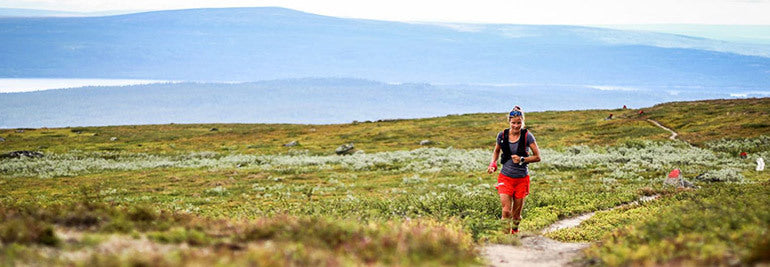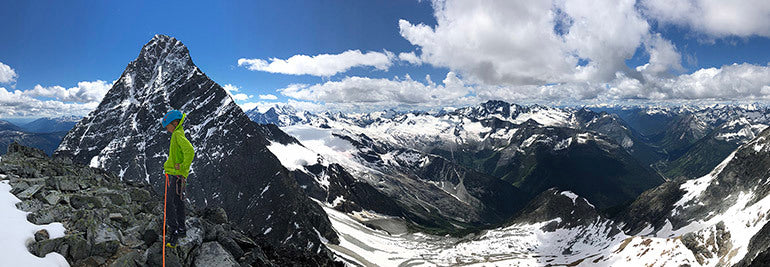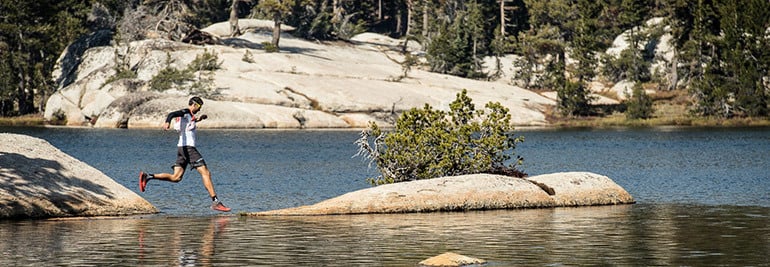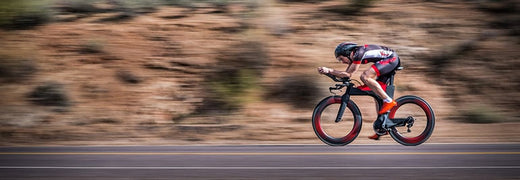

Suunto Blog

Calling all the sporty ladies! Emelie Forsberg smashes four records for women everywhere
This year 32-year-old mountain running champion Emelie Forsberg has done things differently. Rather than focus solely on racing, she turned her attention to challenging personal projects, resulting in her smashing four fastest known time records (FKTs) in a row.
Emelie tracked her Kungsleden FKT with her Suunto 9: She ran about 90km per day for five days straight. (Image by Philipp Reiter)
It all started because Forsberg noticed a dearth of women’s names in the record books for FKTs, and decided to give her own effort to improve that, hoping to inspire other women everywhere to take on fun, personal challenges – big or small – and achieve their dreams. The results are impressive.
“There are very few women who are doing these kinds of things in the mountains, and if I can inspire more to do it, why not?!” she says.
Click play on the Four in a Row video below to watch the action from Emelie’s awesome four FKTs, including new fastest ascent times, and a new record on a long distance trail. Please then all you sporty ladies, head over to her Instagram feed and give her a shout out for her efforts!
Watch Emelie's "4 in a Row" mini-documentary now!
Images by Philipp Reiter

Rickey Gates runs #EverySingleStreet in San Francisco
Gates finished on a rainy day. He ran all the streets in the background. © Dean Leslie / Wandering Fever
After racing in some of the world’s toughest ultras, and running across the United States last year, Rickey Gates expected his #EverySingleStreet project to be long, but light work.
Turns out he hadn’t fully thought through all the vertical gain involved, which amounted to the equivalent of climbing Mount Everest five times. That combined with the distance and complex mapping logistics made it far tougher than he expected.
“It’s ironic, I grew up in the mountains, spent a lot of my life running in the mountains, but the greatest amount of vertical gain I’ve done for one thing has been here in San Francisco,” Gates says. “This project was truly something else!”
© Liz Thorp
Since he started his #EverySingleStreet project, and sent out an invitation on his Instagram feed for others to do the same, runners around the world have heard the call and followed suit. Runners in Germany, Canada, Alaska, Thailand, Finland and elsewhere are running all the streets in their cities, towns and villages.
“It’s really great to see other people take on the challenge,”Gates says. “It seems to offer a different element to some people’s training. For others, having a goal of seeing a map fill in and knowing that you ‘know’ a place on a certain level is empowering.”
In the coming days, Gates will be selecting one of the people running their local streets and giving them his Suunto 9 watch to reward their effort. There will be other giveaways from Salomon.
One of the things Gates enjoyed the most about the project was finding ways to keep himself entertained as he crisscrossed the city. Spotting cats, funny old cars, and graffitti kept him amused. “Doing this makes me more present,” Gates says. “It’s the city equivalent of noting tree or bird species when you’re out in the mountains.”
He also enjoyed connecting with some of the locals he passed each day. “It’s nice to say hi and smile at strangers and to see how far it gets you to know people,” he says.
Lead image: Photo by Gordon Mak on Unsplash

Passing on love of the outdoors to the next generation
At Suunto we believe the more we appreciate and enjoy the great outdoors, the more we will want to protect it. This means those of us fortunate enough to have been given a love of the outdoors have a special responsibility to do as much as we can to ensure the next generation receive the same.
In the same way as ski mountaineer Greg Hill’s parents instilled in him the spirit of adventure and love for the natural world, we can do the same. Even if we don’t have kids, or if they’ve long left the nest, we can support organizations and events that achieve the same.
Passing on the passion
By Greg Hill
I am always a little conflicted around Christmas, societal norms tell me I should be buying gifts for my children. My wife is great, she gets them the things they need and a few of their wants. When I reflect back to the gifts I received as a child, it was the gifts of adventure that I liked best. The gift of a season’s pass at my local ski resort, and the gifts of the gear to ski with. Or the gifts my parents gave without realizing that they were giving them. I have been following their footsteps in this regard.
Our family home was far up a dirt road in Quebec, Canada. Our nearest neighbor was at least one kilometer away, and our house surrounded by deciduous forests. I have very few memories about the town we lived near, most are centered around backyard adventures. I can remember family moments hiking up Round Top mountain, cooking bannoch bread on a stick over an open fire. My parents facilitated my adventures by showing me what was possible. We canoe camped, hiked a lot, downhill skied, Nordic skied, the activities were endless. I cannot thank my parents enough for bringing me up appreciating the outdoors.
Having sparked this thirst for the outdoors, it was impossible to slow it. As I grew, so did my adventurous spirit. I was encouraged to go camping with friends, and the school I went to had an amazing outdoor education component. Soon, I was introduced to rock climbing and it became my gateway sport to mountaineering.
I was captivated by the rewards that came from overcoming the challenges; the intense feeling of accomplishment that followed any climb completed. This feeling was unparalleled and I began searching for it more and more. The challenges evolved from rock to ice, from cliffs to mountains. Soon my whole life was centered around outdoors and adventures.
These moments brought me a source of happiness and overcoming these challenges taught me a lot about myself. Through training hard, working towards harder and harder goals I developed more and more self-confidence. Time in nature taught me patience and an appreciation for nature.
Yet, I accessed all these wild places in a big truck, from a snowmobile or a helicopter. Solo drives to trailheads had me thinking about my impacts. Raising my kids started my questions on how I was living and what legacy I was passing on to them.
There was no profound “aha” moment, but my “eco-anxiety” grew till all of a sudden I needed to change. I have looked at all the aspects of my life and decided to work on what I can. I eat less meat, consider all my lifestyle choices, and drive an electric car. I fly less, and adventure locally a lot more. All of these choices resonate into a better feeling overall and a knowledge that I am trying to be better.
Raising my kids I have been trying to pass on the passion for adventure, and the appreciation for the outdoors. I know how much I have gained from my experiences and can only hope that they get as much from nature as I have.
While out with my kids I truly try and give them the best experiences, keeping the rewards as a priority, aiming for enjoyment, not exhaustion. Showing them the potential, yet letting them come to it on their own terms. Forcing children can easily turn them off activities so I simply encourage and open the doors, hoping they will follow.

How to customize sport modes with Suunto app
Ultra-runner Francois D’haene wants to keep his sport modes simple.
“To be able to personalize my watch is very important for me,” Francois D’haene says.
On his trail running training sessions from home Francois likes to follow altitude, ascent and duration. For interval sessions he adds a screen with a lap table. In an ultra-race another key metric for Francois is distance.
“I don’t want to have 100 things [on my watch screen], I just want to have some important metrics.”
In ultra races duration, distance and ascent are key metrics for Francois.
Despite being first and foremost a runner, Francois also rides bikes and skis. In cycling, especially on the road, he also wants to see his speed and average speed.
When planning a sport mode for ski touring Francois highlights the importance of navigation: He includes a screen with the breadcrumb trail in his ski touring sport mode and usually plans an actual route. These add safety especially in poor weather and in white-out conditions.
LEARN HOW TO CREATE CUSTOM SPORT MODES WITH SUUNTO APP
With dozens of pre-installed sport modes Suunto multisport watches are ready to go for nearly any activity. However, should you prefer something different you can create more sport modes – and you are not limited to just one per activity type. This is useful if you want to see different metrics during a race, an interval workout and a long run, for example.
Learn how to create a sport mode on the iOS version of Suunto app
Learn how to create a sport mode on the Android version of Suunto app
GET SUUNTO APP
If you don’t use Suunto app yet, you can learn more and download it here. With the app you can customize sport modes and more on Suunto 9, Suunto 3 Fitness and Suunto Spartan watches.
KEEP YOUR SUUNTO WATCH UPDATED
For best performance, ensure that you have the latest software installed in your Suunto 9, Suunto 3 Fitness or Suunto Spartan watch: open SuuntoLink on your computer and connect your watch to your computer with its USB cable. SuuntoLink will prompt for an update if one is available.
Images © Damien Rosso / DROZ Photo

D.I.E.T (disaster imminent every time?), and three unchanging principles of nutrition for athletes
What’s the difference between eating healthy and eating right? For athlete, entrepreneur, coach and nutrition expert Dr. Rick Kattouf II this question cuts right to the heart of the debate on nutrition.
“There is a huge difference between eating healthy and eating right,” Kattouf says. “There is a huge difference between feeding the body and fuelling the body. I tell people to stop eating healthy, and they freak out.”
Rick has designed his own line of nutritional supplements. © Rick Kattouf
An example of what Kattouf calls a healthy meal is grilled chicken on a bed of greens, or a bowl of vegetables, beans with a little tofu. While Kattouf agrees these meals are healthy, he says that doesn’t make them right. Eating right is another matter.
Kattouf has credentials to back up his perspective on nutrition for athletes: during four years of pre medicine study and four years of studying optometry he learned about human physiology, pharmacology and biochemistry. The three-time age group national duathlon champion and all-round fitness freak has the performance experience to back up his approach, too.
“There’s a lot of people out there chasing one diet after the next, and one thing I am is an anti diet guy,” Kattouf says. “I trademarked the acronym for the word diet: disaster imminent every time®. That’s what a diet is. My nutrition principles haven’t changed since I was at college. And now I’m 47. Reason being is that human physiology is human physiology.”
Rick Kattouf’s unchanging principles of nutrition
Photo by Danielle Cerullo on Unsplash
When Kattouf starts coaching a new athlete he always asks the same three questions: what time of day do they get out of bed, what time of day they work out and what time do they go to bed. Being clear about this is where a proper nutrition plan begins.
“But what do most people try to focus on? Calories. It’s not about calories in and calories out. It’s all about three key principles: the proper fuelling frequency, the proper fuelling timing, and the right balance of carbohydrates, protein and fat in every meal and snack.”
Photo by Brian Erickson on Unsplash
1. The right ratio
Whether it’s a pro athlete, an age group runner or a morbidly obese person he’s coaching, Kattouf sticks to the same basic meal principle; each meal should consist of about 50 to 60 percent carbohydrates, around 15 to 25 percent protein and between 15 to 25 percent fat.
“For decades we’ve been living with this concept of a higher protein, lower carb diet,” he says. “The carbs have got the dunce hat on and have been shoved into the corner. But what is the only food that the brain can use as fuel? It’s sugars, glucose, carbs, and when we cut those out we’re going to reduce mental acuity, and not get the results we want.”
He says it’s this proper balance of “C-P-F” that plays an important role in stabilising blood sugar, reducing sharp spikes and drops, and helping the body reload. They also help to assist in repairing muscle damage, building muscle, cartilage and bone. These are “macronutrients”, meaning the body needs a large amount of them (and in the right balance) compared to micronutrients like vitamins and minerals.
“There are three things we are going to ask ourselves before every meal or snack: what is my carb, what is my protein, what is my fat. If we can answer all three of those we are moving in the right direction,” Kattouf says
2 & 3. Fuelling frequency and timing
These two are separate, but closely connected. The proper frequency is about how often to eat throughout the day. For optimal performance Kattouf says every two and a half to three hours upon the first snack at waking.
“Fuel your body immediately upon waking, not 30 minutes after, not 60 minutes after, immediately upon waking and then every two to three hours thereafter throughout the day, depending on your goals,” Kattouf says.
The proper timing is about fuelling before, during and after a workout. Having a well balanced snack immediately before a workout and one immediately after is a good start. Especially for endurance athletes, fuelling during is equally important.
Rick’s quick and easy balanced meal
2/3 cup oats1 slice whole grain bread1 TBSP peanut butter3 egg whites
Breakdown:
457 calories52% carbohydrate23% protein25% fat
READ MORE
FUELLING THE ENGINE: A COMMONSENSE APPROACH TO NUTRITION
FUELLING THE ENGINE: TALKING NUTRITION WITH ULTRA RUNNER LUCY BARTHOLOMEW
FUELLING THE ENGINE: TALKING NUTRITION WITH TRIATHLETE MEL HAUSCHILDT
FUELLING THE ENGINE: TALKING NUTRITION WITH TRAIL RUNNER EMELIE FORSBERG
Lead photos by rawpixel and Eaters Collective on Unsplash

The data rules! A pro triathlete’s data driven training approach
When Cody Beals became a triathlete cycling was his weakest discipline. At high school, he was a District All Star in cross country, and a good swimmer. But cycling wasn’t his thing.
The reverse is now true – cycling is his strongest discipline. And it was a data driven approach to his training that made the difference.
For proof, the 28-year-old from Guelph, Ontario won two full distance Ironmans, the first and second of his career. At his first, Ironman Mont Tremblant, he set the bike course and overall course records.
“I undertook a deliberate process of figuring out how to get my cycling up to a world class level,” Beals says. “The biggest thing was getting a power meter – it was a huge revelation! I was wasting so much time on the bike just soft pedalling. With a power meter I learned to make every minute of my riding count.”
© Welle Media
Beals has always been a data freak. He was top of his class at high school, and top of a prestigious physics programme while at university. Back then, he began capturing and analyzing data almost obsessively.
“I made my own monster spreadsheet to track every single last aspect of my life,” he says. “My sleep, my mood, my training – everything. That was when I was a self coached athlete. Even though I was making mistakes, a data approach was always something I believed in.”
After university, Beals has worked in statistics and data analysis, and is using his mastery of these skills to optimise his training. His coach, David Tilbury-Davis, shares a data based training philosophy, and the two work together on that basis. All Beals’s swim, bike and run training is measured and monitored. “The data tells the most compelling story,” he says.
Data analysis has also helped Beals in other ways. Having a Suunto 9 to capture his training runs shows Beals what’s really going on with this runs, not just what he thinks – two very different things. Perceived exertion doesn’t necessarily equate to good performance.
“I've learned through data that how you feel about something sometimes bares no relation to how you're actually performing,” Beals explains. “How I'm feeling is another data point, but it's not the most important. In the absence of power, pace or heart rate data you're just left guessing. The coach can provide part of the reality check, the rest of the reality check comes from these devices and the data they collect.”
© Welle Media
While how he feels about a workout isn’t the most important factor, conversely it is a potentially telling data point. Feeling over the moon isn’t necessarily a good sign, while feeling average isn’t always a bad one.
“I like that the Suunto 9 will prompt you for how you're feeling after each workout, he says. “That's something I have started monitoring more closely. What I've learned is that in a lot of my best training blocks, with almost every single workout, I will feel very medium.
“People assume if you're crushing it leading up to an Ironman, you're feeling great about every session, or maybe some people would assume you are so tired and fatigued that every session is brutally hard.
“The reality is that when I'm putting in my best training blocks, I'm just very stable. Everyday is pretty unremarkable. I'm not putting up epic training sessions. My mood isn't swinging around wildly. It's just day in day out consistency.”
This and other insights help Beals and his coach from avoiding overtraining syndrome, which Beals says is too often a badge of honour in the world of triathalon.
“It's kind of celebrated when athletes can push themselves to extreme lengths in training, but I will tell you that any moron can overtrain themselves,” Beals says. “The hard part is the deliberate, methodical application of training load and on the flip side recovery to reach your true potential.”
Lead image: © Ventum
READ MORE:
SLAYING HIS DEMONS: A PRO TRIATHLETE’S JOURNEY TO FINDING BALANCE










































































